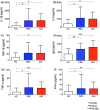Dysbiosis of oral microbiota and its association with salivary immunological biomarkers in autoimmune liver disease
- PMID: 29969462
- PMCID: PMC6029758
- DOI: 10.1371/journal.pone.0198757
Dysbiosis of oral microbiota and its association with salivary immunological biomarkers in autoimmune liver disease
Abstract
The gut microbiota has recently been recognized to play a role in the pathogenesis of autoimmune liver disease (AILD), mainly primary biliary cholangitis (PBC) and autoimmune hepatitis (AIH). This study aimed to analyze and compare the composition of the oral microbiota of 56 patients with AILD and 15 healthy controls (HCs) and to evaluate its association with salivary immunological biomarkers and gut microbiota. The subjects included 39 patients with PBC and 17 patients with AIH diagnosed at our hospital. The control population comprised 15 matched HCs. Salivary and fecal samples were collected for analysis of the microbiome by terminal restriction fragment length polymorphism of 16S rDNA. Correlations between immunological biomarkers measured by Bio-Plex assay (Bio-Rad) and the oral microbiomes of patients with PBC and AIH were assessed. Patients with AIH showed a significant increase in Veillonella with a concurrent decrease in Streptococcus in the oral microbiota compared with the HCs. Patients with PBC showed significant increases in Eubacterium and Veillonella and a significant decrease in Fusobacterium in the oral microbiota compared with the HCs. Immunological biomarker analysis showed elevated levels of inflammatory cytokines (IL-1β, IFN-γ, TNF-α, IL-8) and immunoglobulin A in the saliva of patients with AILD. The relative abundance of Veillonella was positively correlated with the levels of IL-1β, IL-8 and immunoglobulin A in saliva and the relative abundance of Lactobacillales in feces. Dysbiosis of the oral microbiota is associated with inflammatory responses and reflects changes in the gut microbiota of patients with AILD. Dysbiosis may play an important role in the pathogenesis of AILD.
Conflict of interest statement
The authors have declared that no competing interests exist.
Figures




Similar articles
-
The Salivary Microbiota of Patients With Primary Biliary Cholangitis Is Distinctive and Pathogenic.Front Immunol. 2021 Jul 21;12:713647. doi: 10.3389/fimmu.2021.713647. eCollection 2021. Front Immunol. 2021. PMID: 34367180 Free PMC article.
-
Dysbiosis of salivary microbiota in inflammatory bowel disease and its association with oral immunological biomarkers.DNA Res. 2014 Feb;21(1):15-25. doi: 10.1093/dnares/dst037. Epub 2013 Sep 7. DNA Res. 2014. PMID: 24013298 Free PMC article.
-
A disease-specific decline of the relative abundance of Bifidobacterium in patients with autoimmune hepatitis.Aliment Pharmacol Ther. 2020 Jun;51(12):1417-1428. doi: 10.1111/apt.15754. Epub 2020 May 7. Aliment Pharmacol Ther. 2020. PMID: 32383181
-
Implications of gut microbiota in autoimmune liver diseases.Minerva Gastroenterol (Torino). 2023 Mar;69(1):95-106. doi: 10.23736/S2724-5985.21.02860-9. Epub 2021 Apr 1. Minerva Gastroenterol (Torino). 2023. PMID: 33793160 Review.
-
Autoimmune liver diseases and antiphospholipid antibodies positivity: a meta-analysis of literature studies.J Gastrointestin Liver Dis. 2015 Mar;24(1):25-34, 3 p following 34. doi: 10.15403/jgld.2014.1121.amb. J Gastrointestin Liver Dis. 2015. PMID: 25822431 Review.
Cited by
-
The microbiota and the gut-liver axis in primary sclerosing cholangitis.Nat Rev Gastroenterol Hepatol. 2023 Mar;20(3):135-154. doi: 10.1038/s41575-022-00690-y. Epub 2022 Nov 9. Nat Rev Gastroenterol Hepatol. 2023. PMID: 36352157 Review.
-
Veillonella Bacteremia in Alcoholic Hepatitis.Case Reports Hepatol. 2021 Oct 13;2021:9947213. doi: 10.1155/2021/9947213. eCollection 2021. Case Reports Hepatol. 2021. PMID: 34691793 Free PMC article.
-
Causal Effects of Gut Microbiome on Systemic Lupus Erythematosus: A Two-Sample Mendelian Randomization Study.Front Immunol. 2021 Sep 7;12:667097. doi: 10.3389/fimmu.2021.667097. eCollection 2021. Front Immunol. 2021. PMID: 34557183 Free PMC article.
-
Multi-omics analysis reveals gut microbiota-metabolite interactions and their association with liver function in autoimmune overlap syndrome.World J Gastroenterol. 2025 Jul 7;31(25):106371. doi: 10.3748/wjg.v31.i25.106371. World J Gastroenterol. 2025. PMID: 40656611 Free PMC article.
-
Causal associations between gut microbiota and Cholestatic liver diseases: a Mendelian randomization study.Front Med (Lausanne). 2024 Jan 24;11:1342119. doi: 10.3389/fmed.2024.1342119. eCollection 2024. Front Med (Lausanne). 2024. PMID: 38327703 Free PMC article.
References
-
- Kaplan MM, Gershwin ME. Primary biliary cirrhosis. N Engl J Med. 2005; 353: 1261–73. doi: 10.1056/NEJMra043898 - DOI - PubMed
-
- Selmi C, Bowlus CL, Gershwin ME, Coppel RL. Primary biliary cirrhosis. Lancet. 2011; 377: 1600–1609. doi: 10.1016/S0140-6736(10)61965-4 - DOI - PubMed
-
- Krawitt EL. Autoimmune hepatitis. N Engl J Med. 1996; 334: 897–903. doi: 10.1056/NEJM199604043341406 - DOI - PubMed
-
- Avila M., Ojcius D.M. and Yilmaz O. The oral microbiota: living with a permanent guest, DNA Cell Biol. 2009; 28: 405–411. doi: 10.1089/dna.2009.0874 - DOI - PMC - PubMed
-
- Dewhirst F.E, Chen T, Izard J, Paster BJ, Tanner AC, Yu WH, et al. The human oral microbiome, J. Bacteriol. 2010; 192: 5002–5017. doi: 10.1128/JB.00542-10 - DOI - PMC - PubMed
MeSH terms
Substances
LinkOut - more resources
Full Text Sources
Other Literature Sources

